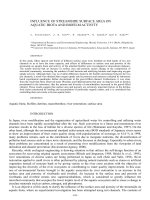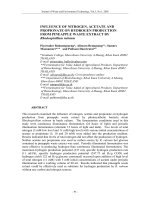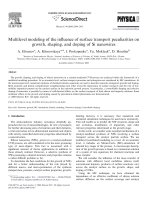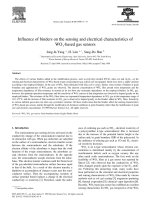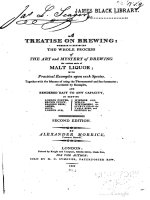Influence of process parameters on microstructures and properties of the heat - Affected zone (HAZ) and fusion zone (FZ) of the dissimilar metal welding
Bạn đang xem bản rút gọn của tài liệu. Xem và tải ngay bản đầy đủ của tài liệu tại đây (729.17 KB, 5 trang )
THE INTERNATIONAL CONFERENCE ON MARINE SCIENCE AND TECHNOLOGY 2016
Influence of process parameters on microstructures and properties
of the heat - affected zone (HAZ) and fusion zone (FZ)
of the dissimilar metal welding
Le Thi Nhung1,
Pham Mai Khanh1, Nguyen Duc Thang2, Pham Huy Tung3
1
Hanoi University of Science and Technology,
2
Centre for non-destructive evaluation
3
Vietnam Maritime University
Abstract
This paper reports the changes of microstructure and properties in the fusion zone
(FZ) and heat - affected zone (HAZ) in dissimilar weld between Austenitic stainless steel
(304L) and low carbon steel under varying of welding parameters. The dimension of base
materials was 500x250x3 (mm). The welding current ranged from 80A to 120A and travel
speed were limited 100-200 mm/s and constant arc voltage of 25V. The welding joints were
made by gas metal arc welding (GMAW). As the result, the microstructures and properties in
three regions had significant differences and changed under vary welding process
parameters. HAZ width and grain sizes in carbon steels are larger than stainless steel.
Besides, tensile strength and hardness were affected by welding parameters. Weld joint at
100A, 120 mm/min would be give the highest tensile strength and hardness.
Keywords: Dissimilar metal welding, welding parameters, HAZ, microstructures, OM.
1. Introduction
Nowadays, dissimilar metal welds are used in many fields such as nuclear, power, oil
and gas or shipbuilding industry,… It was widely known that dissimilar metal joints are
intrinsically an uncertainty because of difference in the physical, mechanical and
metallurgical properties of the base metals to be joined. Besides, the intense heat applied
during process produces both metallurgical and physical inhomogeneity in the various zones
of the weld leading to differential properties of the weld section. Therefore, the investigation
of microstructure, solidification, phase transformation and mechanical properties during
welding process is the best way to understand the essence of welding. In other words, in order
to produce high quality joints, researching all factors affecting to mechanical properties is
necessary.
As the previous researchers, different welding regions in arc welding are classified
into three zones as fusion zone (FZ), heat - affected zone (HAZ) and base metal (BM) which
are influenced by heat input rate and heat transfer factors [3]. FZ is the area between two
pieces of base metal being melted and solidified. HAZ is the area of base metal which is not
melted and has had its microstructure and properties altered by the heat. The change of
welding parameters has different impact on weld geometry, microstructure and properties in
welding zones. For instance, as the heat input and welding speed both increase, the weld pool
becomes more elongated, shifting from elliptical to teardrop shaped [2]. Amuda [1] shows
that, under welding conditions, the primary solidification structure of stainless steel changed
from a predominantly ferrite structure to a matrix interspersed with increasing fraction of
inter - dendrite martensite in the weld metal and grain boundary martensite in the HAZ. In the
carbon welding, ferrite is formed under different shapes as grain boundary ferrite, polygonal
ferrite or acicular ferrite. Besides, upper bainite, lower bainite or Widmanstatten can be
observed [2]. Other researches also represent that grains are smaller, the mechanical welding
is better.
HỘI NGHỊ QUỐC TẾ KHOA HỌC CÔNG NGHỆ HÀNG HẢI 2016
202
THE INTERNATIONAL CONFERENCE ON MARINE SCIENCE AND TECHNOLOGY 2016
Although the researching about cause-effect between welding parameters and
microstructure has invested, the problems concern dissimilar metal welding documents are
limited. Based on previous study, the objective of this study was to find out the changes of
microstructure and properties of welding between carbon steel and stainless steel under the
varying of current and welding speed.
2. Experimental materials and procedure
The base metals were 304L stainless steel and carbon steel using gas metal arc
welding process. The dimensions of plates were 500 x 250 x 3 mm. The chemical composions
of base metals, filler show in the table below.
Table 2.1. The chemical compositions
Alloys (%)
C
Mn
Si
S
P
Cr
Ni
Mo
V
SS 304L
0,09
1,54
0,49
< 0.005
0,005
18.3
7.56
0,13
0,11
Carbon steel
0,1
0,62
0,02
0,04
0,05
0,02
0,08
0.005
0,01
Filler ER 309L
0,08
0.7
0,8
< 0.005
< 0.003
19.7
11.8
0.1
0.09
The welding parameters in the proceses were current and welding speed shown in the
table 2.2. The values of these factors were selected by experimental statistic datas.
Table 2.2. Experimental numbers and welding parameters
Parameters
1
2
3
4
5
6
7
8
9
I (A)
60
80
100
60
80
100
60
80
100
V(mm/min)
120
120
120
160
160
160
200
200
200
Affter welding processes, samples were cut to examine their microstructure, tensile
strength and hardness. The microstructure was observed by OM LEICA MDS4000M. The
tensile strength and the hardness were determined by WEW1000B and hardness tester
ARK600, respectively.
3. Results and discussion
3.1. Microstructure
Because of using filler ER 309L in welding process, austenite (γ) and ferrite (δ) were
formed in fusion zone (figure 3.1a). Generally, grain morphology in FZ is equal structure and
independent of process parameters.
Figure 3.1 (a) Microstructure in fusion zone, V = 160 mm/min, I = 100 A
According the results of hardness test indicate that HAZ width in carbon steel is larger
than stainless steel. This can be expressed by the significant difference of thermal
conductivity between carbon steel and stainless steel. Figure 3.2 shows that HAZ width in
stainless steel is very narrow and concentrates at fusion line.
HỘI NGHỊ QUỐC TẾ KHOA HỌC CÔNG NGHỆ HÀNG HẢI 2016
203
THE INTERNATIONAL CONFERENCE ON MARINE SCIENCE AND TECHNOLOGY 2016
Figure 3.2 Microstructure in HAZ of stainless steel, I =100A, V= 200 mm/min
By comparing microstructure in HAZ of carbon steel, grain size is much larger than
its base metal. This can be observed by comparing grain size in figure 3.2, figure 3.4 with
figure 3.3. Moreover, it depends on welding parameters. Figure 3.4 represents the change of
grain size under varying of current welding. It can be observed that if the current is constant,
the welding speed is slower, heated metal at the high temperature is kept for a long time,
grain size is larger. Meanwhile, if we consider under constant welding speed, the increasing
of current welding is cause of developing of grain size (figure 3.5).
(a) Carbon steel
(b) Stainless steel
Figure 3.3 Microstructure of base metal
.
(a)
(b)
(c)
Figure 3.4 Grain size in HAZ of carbon steel under varying of welding speed, I = 100A
(a) V = 120 mm/min, (b) V = 160 mm/min, (c) V = 200 mm/min
Figure 3.5 Grain size in HAZ of carbon steel under varying of welding current,
V = 200 mm/min. (a) I = 60A, (b) I = 80A, (c) I = 200 A
HỘI NGHỊ QUỐC TẾ KHOA HỌC CÔNG NGHỆ HÀNG HẢI 2016
204
THE INTERNATIONAL CONFERENCE ON MARINE SCIENCE AND TECHNOLOGY 2016
3.2. Mechanical properties
The results of ultimate tensile strength and hardness test for dissimilar welding
between 304L stainless steel and carbon steel were shown significant difference affected of
current and welding speed. Figure 3.6 was shown the estimated means of tensile strength. As
the results, welding parameters at 100A and 120 mm/min would be given the highest tensile
strength.
Tensile strength (KG/mm2)
Welding speed (mm/min)
Figure 3.6 Tensile strength
The values of hardness are represented in the figure 3.7. As can be observed from the
chart, there are small gap among regions. Hardness in HAZ of carbon steel would be higher
than others. Besides, the hardness of sample 3 at 100A, 120 mm/min stand at the highest level
compare with others.
Hardness (HV)
x (mm)
Figure 3.7 Hardness values
4. Conclusion
In this work, stainless steel and carbon steel were jointed using GMAW under varying
of current and welding speed. Microstructure and mechanical properties of weld zones were
investigated. From this study, following conclusions can be drawn:
- The grain sizes observed in fusion zone are equal structure and independent of
process parameters. Meanwhile, microstructure in HAZ of stainless steel and carbon steel has
HỘI NGHỊ QUỐC TẾ KHOA HỌC CÔNG NGHỆ HÀNG HẢI 2016
205
THE INTERNATIONAL CONFERENCE ON MARINE SCIENCE AND TECHNOLOGY 2016
significant difference and controlled by welding parameters. HAZ width and grain sizes in
carbon steels are larger than stainless steel.
- Tensile strength and hardness were affected by welding parameters. Weld joint at
100A, 120 mm/min would be give the highest tensile strength and hardness.
References
[1]. M.O.H. Amuda and s.Mridha. Microstructural features of AISI 430 Ferritic stainless
steel (FSS) weld produced under varying process parameters. international journal of
mechanical and materials engineering (IJMME), Vol. 4 (2009), No. 2. 160 - 166.
[2]. Sindo Kuo. Welding metallurgy. Published by John Wiley and Sons, Inc., Hoboken,
New Jersey. 2003.
[3]. Zakaria Boumerzoug, Chemseddine Derfouf, Thierry Baudin. Effect of welding in
microstructure and mechanical properties of an industrial low carbon steel.
Engineering, 2010, 502-506.
HỘI NGHỊ QUỐC TẾ KHOA HỌC CÔNG NGHỆ HÀNG HẢI 2016
206
